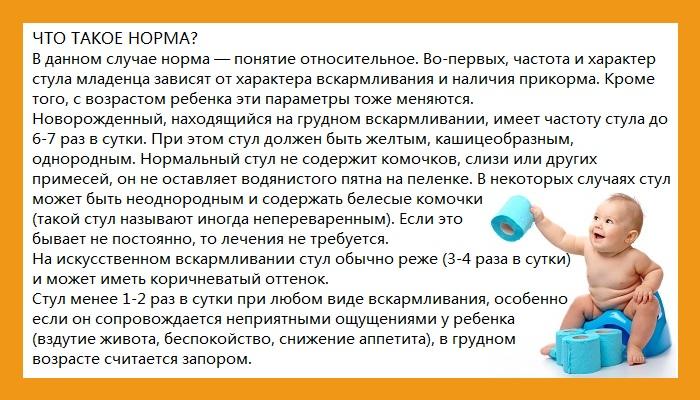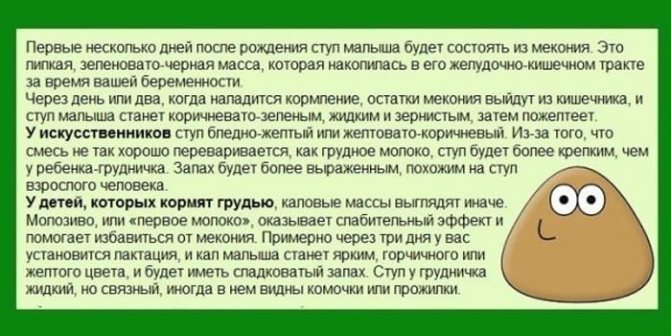What is considered constipation in children?
When introducing complementary foods, parents are very worried and eagerly wait to see how the child will react.
But this reaction is not always positive. Some children have no desire to eat thick and seemingly unattractive vegetable puree, while others begin to have problems with stool - coprostasis occurs. Often, young parents misunderstand the very concept of constipation, which implies not only fecal retention, but also difficulty in defecation. For children of different age groups, the number of trips to the toilet can vary significantly. So, constipation in a 7-month-old child or constipation is an independent bowel movement less than once every 2 days.
It is generally accepted that in infants up to 4 months. there should be stool 2-4 times a day, and by one year 1-2 times a day. Anatomically, the intestine is not yet fully developed, so it does not perform its functions sufficiently.
Often, the mother’s opinion that the child is constipated turns out to be unfounded. The appearance of dense feces and its absence for several days are confusing. As doctors will say, these symptoms are not enough to make a diagnosis, especially in breastfed children. The fact is that breast milk is completely digestible, and the absence of stool for several days is not a symptom of constipation.
lack of milk during breastfeeding, improper introduction of complementary foods. Hard stools in a 7-month-old child may appear due to physical inactivity, prolonged bed rest and the use of certain medications. To eliminate constipation itself, the main thing is to identify its main cause, a doctor will help with this.
Only then will it be possible to talk about successful treatment. In the fight against constipation, it is important to establish a diet that will soften the stool, and select suitable products, normalize feeding and the amount of formula/milk. In addition, it is imperative to carry out gymnastics, exercises that will be aimed at stimulating the abdominal muscles - laying on the tummy, raising the legs up, from a supine position, stroking the baby's tummy clockwise - stimulating peristalsis. The most important rule in the treatment of constipation is not to do anything on your own, especially in prescribing and taking medications.
There are several ways to help make your baby's life easier.
- Warm bath and abdominal massage. Place the baby in the water and massage his tummy clockwise with light, slightly patting movements. Change this type of activity with the “Bicycle” exercise. Place the baby on his back and take the half-bent legs. Make them as if the little one is riding a bicycle.
- More liquid. Make sure your toddler drinks more liquid. If he is already more than two months old, give an additional 50 - 100 ml. water 2 times a day, he should drink this liquid in addition to drinking when he wants. If constipation still occurs, give your baby the same amount of fruit juice, namely pear, apple, grape, cherry.
- Add sugar. It binds fluid in the body. As a rule, it is given along with water, also called “sweetened water”.
- Fruits and vegetables. If your child is already eating solid food, do not forget to include plums, peaches, spinach, and beans in his diet.
A child’s stool is one of the main indicators of his health. That is why mother should constantly check the diaper and know the norms of normal stool. In case of any deviations, consult a doctor immediately.
Hard stool in formula-fed babies
As soon as the baby stops drinking mother's milk, changes can be seen in the stool. It is they who cause concern among parents. Especially in the first stages of feeding, a large number of constipation occurs, which can torment the baby even at night.
Thick stools appear due to the adapted mixture, which is heavy for the baby’s stomach. During this period, it is recommended to establish the nutrition process. Otherwise, both mother and child will suffer for a long time.
A significant reduction in the problem is observed already at the age of 3 or 5 months. During this period, the amount of aggressive mixture reaches high levels and control of its absorption is regulated with the help of compotes. In some cases, vegetable soup or a small amount of vegetable oil will improve the situation.
It happens that a mother is unable to feed her baby breast milk until 3 months. In this case, you will have to replace it with fennel tea, water or milk mixture. At this time, mother is advised to be patient. A newborn's stool may become hard due to:
- hypothermia of the lower abdomen, which the baby receives while bathing.
- inability to digest food mixtures that are too solid;
- preparations containing bifidobacteria or iron;
- using a mixture that is not suitable for age;
- lack of fluid in the body. Can be resolved by consuming fennel tea or water;
- improper preparation of artificial nutrition.
Most often, purchasing cheap infant formula also means obtaining a more aggressive product. Grainy stool occurs more often due to the clumps that are visible in such foods. A high-quality mixture resembles a fine powder and is white in color.
We suggest you read: A child broke his arm, what vitamins to give
Diagnostics of sheep feces
There may be several reasons for the appearance of stool in the form of balls in a child. The most common of them is dysbiosis. It can occur if a pregnant woman has been exposed to infectious diseases. Other reasons:
- C-section;
- improper maternal nutrition and feeding (quick transition to formula, early complementary feeding);
- use of medications with digestive enzymes (“Smecta”, “Imodium”, “Bifidumbacterin”, etc.);
- weak immunity;
- intestinal infection;
- helminthic infestations;
- bad ecology;
- stress.
Dysbacteriosis is also caused by taking antibiotics, in which case constipation may give way to diarrhea. To avoid this condition, after antibiotic therapy, a course of microflora restoration should be prescribed.
You can tell about the appearance of sheep feces by external signs. The baby's feces are similar in appearance to sheep. There may be lumps of mucus and a strong odor. To determine the cause of the condition, the patient is prescribed:
- blood, urine, stool tests for laboratory research;
- bacterial culture for microflora;
- scraping the anal area;
- Ultrasound of the abdominal cavity;
- colonoscopy;
- sigmoidoscopy;
- X-ray of the intestines;
- fibrogastroscopy.
You can get a referral for examinations from a therapist or gastroenterologist.
What changes may indicate
The frequency and appearance of stool may vary depending on the speed and amount of feeding the baby, the composition and degree of thickness of the mixture. If, when taking the same mixtures and products, the stool changes sharply in color and consistency, you must pay attention to this.
Mom should be alerted to unnaturally yellow, orange, green or very dark stool color
. In the first week of a baby's life, stools often have a greenish color, but this is normal. During this period, meconium, the so-called original feces, is excreted from the body. However, such changes in children of several weeks or months of life may indicate disorders.
During the period of introducing fruit juices and purees into complementary foods, the stool may acquire a greenish tint and a heterogeneous consistency with the inclusion of lumps. This is considered a natural phenomenon, but if the stool does not return to normal within 2-3 days after eliminating laxative products from the diet, you should contact your pediatrician.
Frequent, loose, discolored stools usually indicate an intestinal disorder. It can occur due to individual food intolerance, excess fruit on the menu, or intestinal infections. Consultation with a doctor is required in cases where watery, frequent stools are observed for more than a day (in the absence of other disturbing symptoms, otherwise you need to seek the help of a specialist immediately).
Constipation
Another common problem with bottle feeding is constipation. This is indicated by a prolonged absence of stool, a baby’s hard tummy, and crying during bowel movements. In some cases, hard and dry stool after a long period of absence of stool indicates the onset of a cold or other illness (not necessarily).
Prolonged stay of feces in the intestines leads to their hardening and subsequent problems during the process of emptying. Small amounts of blood may indicate that scratches have appeared on the intestinal walls due to too hard stool.
For constipation, it is necessary to stimulate the intestines with a light tummy massage, and to help the baby empty, you can use special enemas for infants. When constipation occurs very often, you need to bring this to the attention of your pediatrician.
If, despite minor changes in stool quality, the baby is cheerful and feels well, no action needs to be taken. Just continue to monitor the child's condition. But if suspicious changes are combined with restless behavior of the baby, loss of appetite and other signs of possible illness, immediately show the child to the doctor.
Possible reasons
It is worth reassuring young mothers, because constipation is not something terrible. To some extent, this is a normal reaction of the body, as it adapts to digesting food that is more complex in structure. You need to think about it, because breast milk, after entering the stomach, remains in it for only 15 - 20 minutes, then enters the small intestine, where all important microelements are absorbed.
These include:
- switching to new foods too early;
- poor nutrition of the mother, namely the consumption of protein products such as meat, cottage cheese, rice, tea, coffee drinks, baked goods;
- incorrect choice of formula for feeding;
- lack of drinking regime;
- food portions are too large;
- incorrectly chosen product for complementary feeding;
The problem is that the work of the intestines is closely interconnected with the state of the child’s nervous system and directly depends on the influence of the surrounding world. Therefore, stress and overexertion lead to decreased peristalsis and constipation.
It is a known fact that about 100 different beneficial and harmful microorganisms live in the human intestines. All of them are involved in the process of digesting food, neutralize toxins and strengthen the immune system. But if the microbial balance is disturbed, the state of health deteriorates sharply, resulting in constipation.
Food allergies
Allergic reactions can occur under the influence of any product eaten by the mother or child, for example, milk, various cereals containing gluten, or red plant foods. And the manifestations will be excessive dryness of the skin and its redness. Itching and rashes may occur.
A newborn's stool may be different colors, but it will be normal. The color depends on the composition of the mother's milk, its consistency, and the degree of population of the baby's initially sterile intestines with beneficial and opportunistic microflora. The main shades and the reasons for their appearance are described in the table.
| Stool color | Possible reasons |
| Green |
|
| Yellow |
|
| Orange |
|
| Yellow-brown |
|
| Black |
|
| White |
|
How to recognize the problem
Many parents begin to worry if their newborn has rare bowel movements. However, infrequent bowel movements do not always indicate constipation. Children who receive formula as food or are on mixed feeding go to the toilet less often than their peers who are fed mother's milk. This is due to the rapid formation of the enzyme environment, which means that there is nothing wrong with rare stools, 1-2 times a day.
First of all, it is not the frequency of bowel movements that should cause concern, but the consistency of its contents. If your baby has rare but soft stools, don’t worry and don’t run for an enema, everything is fine with your baby. But if you notice that the stool is hard and it hurts your child to go to the toilet, start sounding the alarm.
With normal stool consistency, bowel movement once every 3 days is considered acceptable with artificial nutrition. If there is no bowel movement for more than 4 days, you can suspect that the newborn is actually constipated.
According to pediatricians, those babies who are bottle-fed are more likely to suffer from constipation. The reason for this is the composition of baby food, which contains fatty amino acids and unnatural additives. Babies' stomachs are not designed to digest such components, as a result of which the digestion process takes longer and the intestines simply do not have time to empty themselves in time.
However, artificial nutrition does not always lead to constipation in newborns; the digestive system can malfunction for reasons such as:
- Sudden change in food type. For example, if you breastfed your baby from birth and suddenly for some reason switched him to artificial formula, the intestines may react with constipation.
- Lack of fluid. Unlike children who receive breastfeeding, formula-fed children must be supplemented with water. This will help replenish the lack of fluid that leads to constipation.
- Frequent change of food brands. The composition of baby food from different manufacturers may vary. It is for this reason that formula-fed children need to be fed the same brand of formula. In this case, the baby’s stomach adapts to food faster and digestion is normalized.
- Disturbances in the balance of intestinal microflora. Dysbacteriosis can occur from taking antibacterial drugs, artificial feeding from birth, passive smoking, stress, and birth injuries. The diagnosis can only be made by a specialist who will prescribe adequate therapy. Children who receive breast milk rarely experience this phenomenon, since all the beneficial microbes are transferred to them through mother's milk. Also, constipation is quite common in children with mixed feeding. Especially if the mother or baby is receiving antibiotics.
- Psychological causes of constipation are also not uncommon. This can happen to a child older than 8 months. At this time, the baby begins to understand that he wants to go to the toilet and a one-time pain during bowel movements can cause fear. For this reason, the child may not tolerate going to the potty, which ultimately leads to constipation.
- The problem can also be caused by the peculiar structure of the intestines. This problem should go away on its own by school age.
Reading time: 5 minutes
After birth, the baby's feces depend on the form of nutrition. If his mother breastfeeds him, then normally the stool has a soft consistency and yellow color. When a baby is transferred to artificial feeding, the stool becomes denser and the color becomes darker, which is due to the low protein content of mother's milk.
The child has hard stool. How can I help you?
Hard stool is a sign of incomplete bowel movement. Normally, the frequency of bowel movements should be at least once every two days. If this does not happen, the stool in the rectum begins to harden. As a result, stool becomes irregular, it becomes painful for the baby to poop, pain in the abdomen, general weakness, and nausea may occur. If a child has hard stools, parents will learn how to soften them from the following recommendations:
- To soften the stool, the child must be given a lot of liquid, mainly clean, drinking water.
- Fiber should predominate in the diet; you need to increase the consumption of vegetable dishes, fruits, and dried fruits.
- Until the child’s condition returns to normal, it is not recommended to give him flour products.
- It is beneficial for a baby to drink unsweetened, homemade kefir.
- You can treat constipation at home by massaging the abdomen, movements should be circular, clockwise.

Parents can also alleviate the condition with the help of syrups: Lactulose, Duphalac, Normaze, Lactusana, etc. The use of drugs is often prohibited. If the use of methods does not help, constipation does not disappear within several days, you should consult a doctor.
Green stool: what does it mean?
The chair is white. Be sure to consult a doctor if your child's stool is creamy-white: this indicates possible liver problems. Take your baby to the doctor as soon as possible and, if you can, take a small stool sample with you. White stools are full of fat that is not absorbed by the intestines. This type of stool does not sink, but it is difficult to tell if the baby poops in the diaper.
The chair is green. The only time you should be concerned about green stool is if your baby also has a fever (above 38ºC) and is vomiting or looks unwell, because these are all signs of a stomach infection. In this case, also take your child to the doctor as soon as possible, since the disease can lead to dehydration.
It is not uncommon for infants to have a mild intestinal infection that results in green stools, but overall the baby feels well. Such infections often go unnoticed, so if nothing bothers the child, then there is no need to worry about green stool.
There are other causes of green stool: medications you give your baby or iron supplements you take while breastfeeding. In addition, your baby may be sensitive to some foods in your diet, but in this case he may also experience other symptoms, in particular dermatitis. If you suspect this is the case, contact your doctor and ask for a referral to a dietitian.

The stool is red or black. Red or black color indicates blood in the baby's stool, and this can be dangerous, although most often the cause turns out to be relatively harmless - cracks in the nipples of a nursing mother. But you should definitely report the problem to your doctor if your baby seems to be feeling unwell, because sometimes blood in the stool indicates a serious illness.
So, the most common reason for blood in the stool is if you are breastfeeding and you have cracked nipples: when the baby sucks, he can easily suck out quite a lot of blood along with the milk. This will not cause him any harm, and you only need to worry about your own health and the correct attachment of the baby to the breast - usually it is due to a violation of attachment that cracks appear. Such stool may also be black in color because the blood is digested and in the intestines changes color from bright red to black.
Another reason for black stool is if the child was prescribed iron supplements.
The stool may contain blood if the child has an anal fissure (rupture) due to constipation. You won't be able to see the crack yourself, but the blood will be bright red and will cover the stool like a film. Fissures usually heal on their own, but you should try to ensure that your child is not constipated.
If a child has diarrhea, blood in the stool may be due to an intestinal infection or because the intestinal wall is damaged. If this is the case, then the child will look as if he is feeling very unwell, in which case it is necessary to urgently consult a doctor.
Symptoms
Often everyone is accustomed to thinking that constipation in a 7-month-old child is characterized only by stool retention. But there are a number of other signs that support this diagnosis:
- Difficulties during the act of defecation. The baby strains, the face appears red, the stomach is in constant tension, and often cries.
- Feces of heterogeneous structure. It may become denser, look like peas, or, on the contrary, be mushy.
- Periodicity. Feces are passed every 2-3 days.
How to act in case of false constipation
Note that breast milk is digested almost completely, so after six months, children’s bowel movements will become less frequent - once a day, or even less often - up to 2-3 times a week. If this does not bother the child, and he has bowel movements without problems, then such a schedule can be considered quite normal, and no measures should be taken.
As a rule, in newborns and in the first few months of life, difficulties in excreting feces are very common. This worries parents, who immediately try to actively stimulate the child to have bowel movements. To do this, they use enemas, laxatives, gas tubes and even soap.
Treatment by a gastroenterologist
Due to the fact that the introduction of complementary foods is accompanied by the appearance of constipation in infants, pediatricians recommend being careful when changing a child’s diet and always being ready to help him.
There are many methods to alleviate a child’s condition with stool retention without the use of pharmacological drugs. Usually they are of an auxiliary nature in the context of drug treatment, however, with mild constipation, you can do without pills.
If symptoms of spasmodic constipation recur regularly in a child, treatment is carried out by a gastroenterologist. The doctor conducts intestinal examinations to confirm or refute pathologies that could cause the appearance of dense stool. When diseases are detected, therapy is aimed at treating them and eliminating constipation.
To soften hard stools, a specialist will recommend drinking 2 liters of clean water a day and eliminating foods that irritate the intestines from your diet.
Treat spasmodic constipation:
- "Duspatalin" (increases peristalsis);
- "Lactusan" (has a laxative effect);
- "Linex" and "Bifiform" (restore intestinal microflora).
In some cases, surgery may be required; it helps solve the problem of intestinal deformities, tumors, and fecal impactions.

Constipation must be treated. Ignoring symptoms leads to accumulation and rotting of stool. Intoxication of the body occurs, the following appears:
- irritability;
- headache;
- bad feeling.
Neglected conditions lead to anal fissures, intestinal prolapse, hemorrhoids, and colon cancer.
For severe constipation, enemas can be done to soften stool, but not too often. They use warm water, an infusion of herbs, and add oils to them.
What should you pay attention to to solve the problem of constipation in a child?
In order to correctly, effectively and safely solve the problem of constipation in a child, pay attention to the following points:
1. Assess how often your child experiences constipation and what is the tendency for this problem to develop?
The first thing to do when faced with the problem of constipation in children is to assess how often the child experiences constipation.
The child has rare constipation (episodes of normal stool significantly exceed the frequency of episodes of hard stool)
- Rare cases of constipation are completely normal and can occur from time to time in all healthy children.
- Usually, rare constipation is not associated with any serious intestinal diseases and does not require a visit to the doctor (unless there are other signs of illness in the child)
- Rare episodes of constipation do not require any special treatment and can only be resolved through first aid measures, which will be described below in the Treatment section.
Frequent constipation (when episodes of hard stools outnumber episodes of normal soft stools or when the child has prolonged episodes of hard stools)
- Frequent cases of constipation should be considered abnormal and a possible sign of a serious illness
- Frequent constipation can cause changes in the structure of the child's intestines (acquired megacolon) and cause fecal incontinence (encopresis)
- A child with frequent episodes of constipation should be seen by a doctor to determine the causes of the disease and carry out special treatment.
2. Assess the child’s general well-being
Regardless of how often a child experiences constipation, try to assess the child’s general well-being using the following criteria:
- How, in general, does the child behave? Can we say that he is restless, irritable, has no interest in the events happening around him, is too sleepy, does not play much?
- How does a child develop? Have you noticed that he is behind in height or weight?
- Have you noticed a certain lag in the child’s mental development?
- What does the child look like externally? Does his skin and hair look dry and flabby? Does he have a skin rash?
- Have you noticed that your child often “stains his laundry” with feces?
Children with rare episodes of constipation that are not associated with any serious illness usually appear completely healthy and develop well.
Children with frequent constipation, on the contrary, may suffer from some serious diseases that are manifested not only by constipation, but also by other symptoms that create the impression of a “sick, apathetic child” and can provoke the child to lag in height, weight and mental development.
| If a child with frequent constipation seems sick to you, you notice the appearance of some symptoms that you do not understand (rash, apathy, etc.), and also if you determine that he is developing more slowly than his peers, be sure to consult a doctor. |
Prevention
Having studied in detail all the details of this disorder of the digestive tract and provided assistance to the child, do not forget about the further prevention of constipation in the infant after the introduction of complementary foods. The main thing is to follow a few rules:
- You should not sharply increase the portion of food your child eats;
- It is necessary to introduce complementary foods with dishes that consist of only one product;
- Normalize the water-drinking regime of infants (about 200 ml per day);
- It is necessary to follow a feeding schedule, trying to eat food at the same time;
- Encourage your child to be active.
Based on the above, we can conclude that it will be extremely difficult to avoid constipation in a child at seven months, since the intestines are not yet sufficiently adapted to digesting new products for him, since the baby has not previously tried anything other than breast milk and artificial formula. It is better to start introducing complementary foods directly under the guidance of a pediatrician. If the first negative symptoms occur within 2 days after consuming an unfamiliar product, the mother should stop this process.
Color, consistency and regularity of stool in bottle-fed babies
The consistency, color and regularity of stool depends on the age of the child, the type of formula and the amount of complementary foods. The process of defecation should be painless.
A bottle-fed baby's stool should be regular.
The stool of a formula-fed baby has a distinct odor and a mushy consistency. Even the best formula is absorbed much worse than mother's milk, so you can see cheesy clots in the stool.
Parents need to monitor the regularity of the process. The frequency of bowel movements is an individual indicator. But a baby up to six months should defecate 3-4 times per day. Children aged 6-7 months and older poop less often - 1-2 times a day. If a child does not defecate for more than a day, he should be given an enema or at least a tummy massage. When stool remains in the intestines for a long time, it hardens. The result is constipation.
Formula-fed baby's stool
If the baby has to be artificially fed, it is necessary to take into account that his intestinal functioning changes. Accordingly, everything that is connected with such a prosaic and important process as pooping changes.

It would seem that with “artificial” everything should be simple - a sterile bottle, the same mixture. And there shouldn't be any problems. But it is not so. Each person’s body is unique, and a baby’s body is especially unique. So how should a bottle-fed baby poop and how is the stool of “artificial-fed” babies different?
The color of the stool is darker. Although it may depend on the mixture itself, it can range from yellow to dark brown.
What should you be wary of??
If the color of the stool is unnaturally yellow or orange, there is a problem with the liver.
If it is green, this means various types of dysbacteriosis.
The only exception when there is no need to worry is when the child is under a week old. Green stool at this age is natural; it is meconium.
If it is very dark, almost black, it means there is blood in the stool.
Causes of sticky stool in infants
If your child has sticky stool, it does not necessarily indicate that he or she is sick. There may be several reasons for this:
- Unusual food for a child. This may be due to the fact that the mother ate a new product, or the baby received a portion of an unfamiliar mixture;
- Not drinking enough fluids during the day. “Artificial” drinks must be supplemented to facilitate the absorption of the mixture;
- Increased gas formation, which is a harbinger of constipation;
- Lactase deficiency;
- Lack of nutrients in the baby’s body;
- Mom's milk is too fatty.
Note! If feces sticks to the diaper and is difficult to wash off from the butt, but the baby feels well, this is not considered a pathology. As a child grows, his weight increases, he sleeps peacefully and sweetly, eats with appetite, and there is no need to worry.
Normal consistency of baby stool
Ideal baby stool has a mushy consistency and a light brown color.
It should not be completely absorbed into the diaper. Note! The stool becomes more formed with the start of complementary feeding. Depending on the foods consumed, its shade changes, and pieces of food may appear.
Newborns produce meconium, which is always sticky and thick, reminiscent of motor oil. Even its color is black, it shouldn’t be scary. It appears almost immediately after the baby is born and consists of mucus, water, hair, everything that was digested during intrauterine life. Then the newborn's stool changes, reacting to the mother's milk or formula, and becomes more mushy.
Differences in the feces of bottle-fed and breastfed children
The color, consistency and volume of stool is one of the main indicators of a baby’s health. It is important for parents and pediatricians to pay attention to the presence of inclusions in a homogeneous mass of bowel movements. When a baby is breastfed, his feces are normally homogeneous, without impurities and liquids.
If the mother's milk is fatty, then the consistency becomes thick like sour cream. The color of stool is yellow.
The stool has a sweetish-sour odor because the newborn's body only digests mother's milk, which is low in casein protein.
A bottle-fed baby's stool becomes thicker. The consistency of the stool resembles ointment. The color of feces becomes dark yellow, and the smell becomes more pronounced. Some inclusions are allowed, since the milk mixture is not completely digested.











